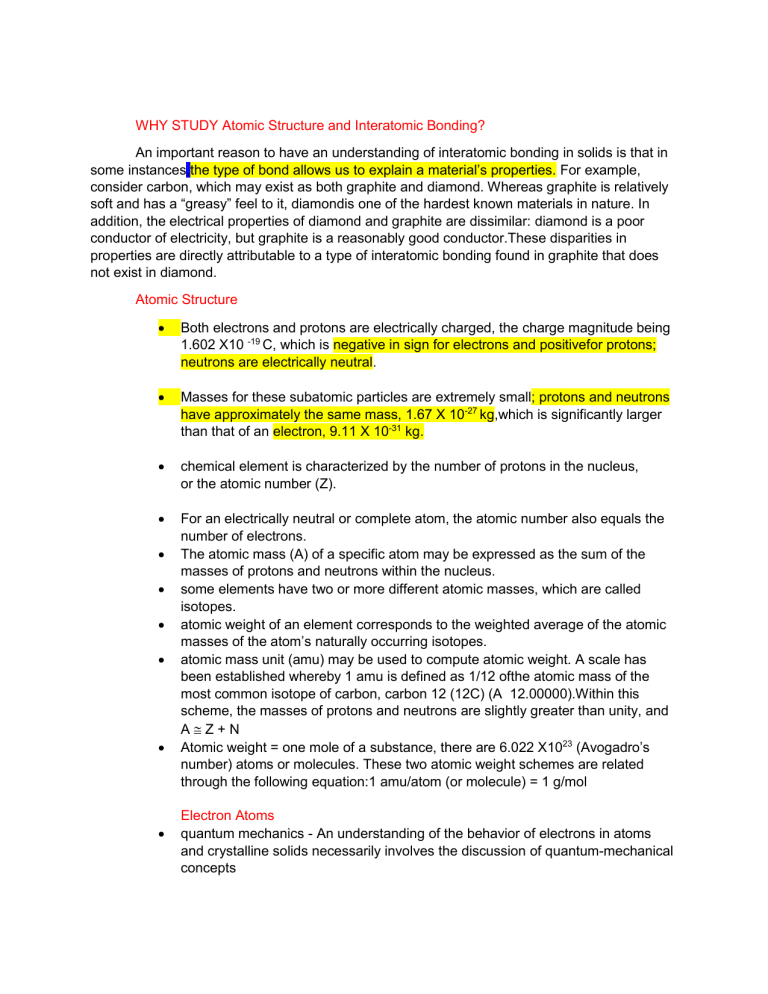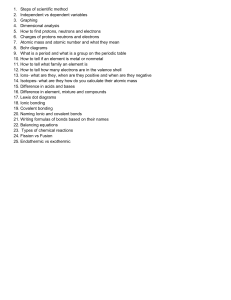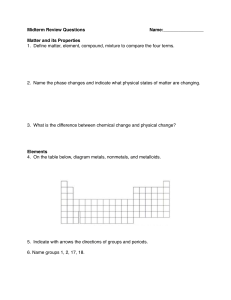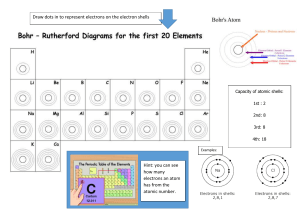
WHY STUDY Atomic Structure and Interatomic Bonding? An important reason to have an understanding of interatomic bonding in solids is that in some instances,the type of bond allows us to explain a material’s properties. For example, consider carbon, which may exist as both graphite and diamond. Whereas graphite is relatively soft and has a “greasy” feel to it, diamondis one of the hardest known materials in nature. In addition, the electrical properties of diamond and graphite are dissimilar: diamond is a poor conductor of electricity, but graphite is a reasonably good conductor.These disparities in properties are directly attributable to a type of interatomic bonding found in graphite that does not exist in diamond. Atomic Structure Both electrons and protons are electrically charged, the charge magnitude being 1.602 X10 -19 C, which is negative in sign for electrons and positivefor protons; neutrons are electrically neutral. Masses for these subatomic particles are extremely small; protons and neutrons have approximately the same mass, 1.67 X 10-27 kg,which is significantly larger than that of an electron, 9.11 X 10-31 kg. chemical element is characterized by the number of protons in the nucleus, or the atomic number (Z). For an electrically neutral or complete atom, the atomic number also equals the number of electrons. The atomic mass (A) of a specific atom may be expressed as the sum of the masses of protons and neutrons within the nucleus. some elements have two or more different atomic masses, which are called isotopes. atomic weight of an element corresponds to the weighted average of the atomic masses of the atom’s naturally occurring isotopes. atomic mass unit (amu) may be used to compute atomic weight. A scale has been established whereby 1 amu is defined as 1/12 ofthe atomic mass of the most common isotope of carbon, carbon 12 (12C) (A 12.00000).Within this scheme, the masses of protons and neutrons are slightly greater than unity, and AZ+N Atomic weight = one mole of a substance, there are 6.022 X1023 (Avogadro’s number) atoms or molecules. These two atomic weight schemes are related through the following equation:1 amu/atom (or molecule) = 1 g/mol Electron Atoms quantum mechanics - An understanding of the behavior of electrons in atoms and crystalline solids necessarily involves the discussion of quantum-mechanical concepts Bohr atomic model - which electrons are assumed to revolve around the atomic nucleus in discrete orbitals,and the position of any particular electron is more or less well defined in terms of its orbital. a wave-mechanical model - which the electron is considered to exhibit both wave-like and particle-like characteristics. With this model, an electron is no longer treated as a particle moving in a discrete orbital; rather, position is considered to be the probability of an electron’s being at various locations around the nucleus. In other words, position is described by a probability distribution or electron cloud. every electron in an atom is characterized by four parameters calledquantum numbers. The size, shape, and spatial orientation of an electron’s probability density (or orbital) are specified by three of these quantum numbers. Shells are specified by a principal quantum number n, which may take on integral values beginning with unity; sometimes these shells are designated by the letters K, L, M, N, O, and so on electron states—values of energy that are permitted for electrons. Pauli exclusion principle, another quantum-mechanical concept, which stipulates that each electron state can hold no more than two electrons that must have opposite spins. When all the electrons occupy the lowest possible energies in accord with the foregoing restrictions, an atom is said to be in its ground state. electron configuration -structure of an atom represents the manner in which these states are occupied. In the conventional notation,the number of electrons in each subshell is indicated by a superscript after the shell– subshell designation. valence electrons are those that occupy the outermost shell. These electrons are extremely important; as will be seen, they participate in the bonding between atoms to form atomic and molecular aggregates. Furthermore, many of the physical and chemical properties of solids are based on these valence electrons. electron configurations - the states within the outermost or valence electron shell are completely filled. (Ne, Ar, Kr, and He)- the inert, or noble, gases, which are virtually unreactive chemically. Some atoms of theelements that have unfilled valence shells assume stable electron configurations by gaining or losing electrons to form charged ions or by sharing electrons with other atoms. Periodic Table elements are situated, with increasing atomic number, in seven horizontal rows called periods. The arrangement is such that all elements arrayed in a given column or group have similar valence electron structures, as well as chemical and physical properties. electropositive elements -indicating that they are capable of giving up their few valence electrons to become positively charged ions. electronegative—that is, they readily accept electrons to form negatively charged ions, or sometimes they share electrons with other atoms. BONDING FORCES AND ENERGIES the bonding energy - two atoms corresponds to the energy at this minimum point; it represents the energy required to separate these two atoms to an infinite separation. primary or chemical bond - the bonding necessarily involves the valence electrons;furthermore, the nature of the bond depends on the electron structures of the constituent atoms. In general, each of these three types of bonding arises from the tendency of the atoms to assume stable electron structures, like those of the inert gases, by completely filling the outermost electron shell. Ionic bonding - is perhaps the easiest to describe and visualize. It is always found in compounds composed of both metallic and nonmetallic elements, elements situated at the horizontal extremities of the periodic table. ( transfer ) a. coulombic force - that is, positive and negative ions, by virtue of their net electrical charge, attract one another. For two isolated ions, the attractive energy EA is a function of the interatomic distance according to Ea = -A/r b. Ionic bonding is termed non directional that is, the magnitude of the bond is equal in all directions around an ion. It follows that for ionic materials to be stable, all positive ions must have as nearest neighbors negatively charged ions in a threedimensional scheme, and vice versa. c. Bonding energies, which generally range between 600 and 1500 kJ/mol, are relatively large, as reflected in high melting temperatures. covalent bonding - found in materials whose atoms have small differences in electronegativity that is, that lie near one another in the periodic table. a. the covalent bond is directional that is, it is between specific atoms and may exist only in the direction between one atom and another that participates in the electron sharing. b. hybridization—the mixing (or combining) of two or more atomic orbitals with the result that more orbital overlap during bonding results. Metallic bonding, the final primary bonding type, is found in metals and their alloys. -or forming a “sea of electrons” or an “electron cloud.”The remaining nonvalence electrons and atomic nuclei form what are called ion cores,which possess a net positive charge equal in magnitude to the total valence electron charge Metals are good conductors of both electricity and heat as a consequence of their free electrons Secondary bonds, or van der Waals physical) bonds are weak in comparison to the primary or chemical bonds; bonding energies range between about 4 and 30 kJ/mol. -evidenced for the inert gases, which have stable electron structures. In addition, secondary (or intermolecular) bonds are possible between atoms or groups of atoms, which themselves are joined together by primary (or intramolecular) ionic or covalent bonds. dipole - some separation of positive and negative portions of an atom or molecule. The bonding results from the coulombic attraction between the positive end of one dipole and the negative region of an adjacent one may be created or induced in an atom or molecule that is normally electrically symmetric—that is, the overall spatial distribution of the electrons is symmetric with respect to the positively charged nucleus Hydrogen bonding - special type of secondary bonding, is found to exist between some molecules that have hydrogen as one of the constituents. polar molecules - Permanent dipole moments exist in some molecules by virtue of an asymmetrical arrangement of positively and negatively charged regions; such molecules Polar molecules can also induce dipoles in adjacent nonpolar molecules, and a bond forms as a result of attractive forces between the two molecules; the magnitude of this bond is greater than for fluctuating induced dipoles. Coulombic forces also exist between adjacent polar molecules.The associated bonding energies are significantly greater than for bonds involving induced dipoles. MIXED BONDING a bonding tetrahedron - a three-dimensional tetrahedron with one of these “extreme” types located at each vertex we should point out that for many real materials, the atomic bonds are mixtures of two or more of these extremes (i.e., mixed bonds). Three mixedbond types— covalent–ionic, covalent–metallic, and metallic–ionic—are also included on edges of this tetrahedron mixed covalent–ionic bonds, there is some ionic character to most covalent bonds and some covalent character to ionic ones. -this type of bond is represented between the ionic and covalent bonding vertices. The degree of either bond type depends on the relative positions of the constituent atoms in the periodic table or the difference in their electronegativities. The wider the separation (both horizontally—relative to Group IVA—and vertically) from the lower left to the upper right corner (i.e., the greater the difference in electronegativity), the more ionic is the bond. mixed bond is found for some elements in Groups IIIA, IVA, and VA metalloids or semi-metals, and their properties are intermediate between the metals and nonmetals. In addition, for Group IV elements, there is a gradual transition from covalent to metallic bonding as one moves vertically down this column for example, bonding in carbon (diamond) is purely covalent, whereas for tin and lead, bonding is predominantly metallic. Mixed metallic–ionic bonds are observed for compounds composed of two metals when there is a significant difference between their electronegativities. This means that some electron transfer is associated with the bond inasmuch as it has an ionic component. Furthermore, the larger this electronegativity difference, the greater the degree of ionicity.





